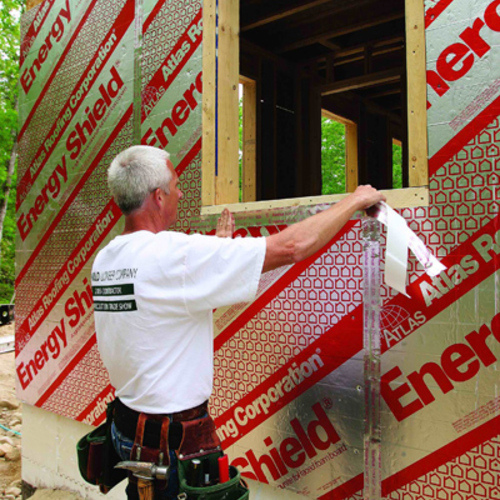
When I published my first Energy Quiz over a year ago, a reader posted the comment: “I want another quiz.” Okay — we aim to please.
Remember, using Google for research is cheating. Answers are at the bottom of the page.
1. Evaporative coolers:
a. Perform better in a dry climate than a humid climate.
b. Perform better in a humid climate than a dry climate.
c. Don’t work very well anywhere in the U.S.
2. To insulate basement walls in Climate Zone 6 with XPS, what is the minimum thickness required by the 2006 IRC?
a. One inch.
b. Two inches.
c. Three inches.
3. When home inspectors see tongue-and-groove ceiling boards:
a. They smile, because tongue-and-groove boards are a natural (and green) choice for ceilings.
b. They smile, because 3/4-inch-thick boards add to a ceiling’s R-value.
c. They become concerned, because such ceilings often lack an air barrier.
4. The wall and roof insulation used in the hut erected in 1910 by Robert Falcon Scott at Cape Evans in Antarctica was:
a. Straw
b. Quilted seaweed
c. Sealskin
5. In a Florida home with an unconditioned attic:
a. It’s helpful to bury attic ducts in a deep layer of cellulose insulation.
b. Burying attic ducts in cellulose insulation can lead to moisture problems.
6. The soil used in a typical “green” (vegetated) roof:
a. Has a significant R-value, greatly improving the insulating value of the roof.
b. Has a low R-value — less than required for a typical roof — and is more expensive to install than conventional insulation.
7. The process whereby the moisture content of a porous (hygroscopic) building material increases is referred to as:
a. Capillary action.
b. Permeance.
c. Sorption.
8. Of all the windows sold in Sweden in 2002:
a. 20% were triple-glazed.
b. 50% were triple-glazed.
c. 80% were triple-glazed.
9. The 2009 IRC requires builders:
a. To…
Weekly Newsletter
Get building science and energy efficiency advice, plus special offers, in your inbox.

This article is only available to GBA Prime Members
Sign up for a free trial and get instant access to this article as well as GBA’s complete library of premium articles and construction details.
Start Free TrialAlready a member? Log in















28 Comments
Number 5
Martin,
can you explain No.5 in more detail....
Would this include ducts that are well sealed with mastic and wrapped with insulation?
Are there any other "downsides" to using cellullose as an attic floor insulation in a Humid Climate?
Ducts in unconditioned attic
John,
If you install insulated flex duct in an unconditioned attic -- that is, typical flex duct with anything from R-4 to R-8 insulation and a vinyl jacket -- the vinyl jacket never gets cold enough to permit condensation to form on the exterior of the vinyl, even in the summer when the air conditioner is running. Basically, the thin duct insulation plus the warming effect of the hot attic air keep the vinyl jacket warm enough to prevent condensation.
But what if you bury the duct in a vapor-permeable insulation like cellulose or blown-in fiberglass? Now you've isolated the vinyl jacket from the hot attic air. The exterior of the vinyl jacket is now cold enough to support condensation -- after all, the vinyl jacket is being cooled by the conditioned air in the duct, and the thick cellulose is keeping the jacket at a low temperature.
But the cellulose is not a vapor barrier, so the humidity in the hot, humid attic easily passes through the cellulose, and the condensation begins to form on the exterior of the vinyl duct jacket.
Drip, drip, drip.
Downsides to using cellulose in a humid climate
John,
I don't think there are any downsides to using cellulose in a humid climate, as long as your ductwork is within the home's conditioned space.
# 20
So I understand that compressing the batt can increase the R-value of the actual batt. Isn't also true that compressing the batt (say R-19 into a 2x4 wall) decreases the performance of the insulation in that wall?
Compressing a fiberglass batt
Dylan,
Compressing a fiberglass batt decreases the R-value of the batt but increases the R-value per inch.
If you compress an R-19 batt (with a nominal thickness of 6.25 in. and an R-value of R-3.0 per inch) into a 3.5-in. deep cavity, you don't get R-19. You get R-13 (R-3.7 per inch). You just increased the R-value per inch, but decreased the R-value of the batt.
In the old days, standard batts for 2x4 walls were R-11 batts (R-3.1 per inch), so it made sense to buy an R-19 batt and compress it into a 2x4 cavity, assuming you wanted R-13.
Now, however, fiberglass batt manufacturers have responded to requests for denser insulation, and it's possible to buy an R-15 batt intended for a 3.5-in. cavity.
Another example of compression math: If you take an R-30 batt with a nominal thickness of 9.5 in. (R-3.1 per in.) and you compress it into a 2x6 cavity, you get R-21 (R-3.8 per in.) You have decreased the R-value of the batt but you have increased the R-value per inch.
ducts in hot-humid
You can get a similar issue if ducts are bundled together in a vented attic (valley rafters constricting ducts to a wing) the spaces between the ducts get cold enough to condense.
John B's top-hat roof system with the flat trusses and deck would keep air flow away from the ducts and allow them to be buried in cellulose (or spider) without trouble. I'm teaching the NAHB Building Science class next month, maybe we'll use that as a case study on the Climate consultant software. Hope to set up some South East specific examples.
Enjoyable test, thanks. (you got me on the bath fan question)
fiberglass
Martin,
Thanks the English and the math explanations have never synced very well with me , and now I understand. To paraphrase, by stuffing a larger batt into a smaller cavity you will increase the R-value per inch but reduce the overall R-value of the batt itself. Thereby, increasing your costs for small marginal gains.
More on fiberglass compression
Dylan,
Here is the Owens Corning chart giving R-values for compressed fiberglass batts [click on the image to enlarge it]:
.
Dylan dense packed insulation is a good thing
Fiberglass batts are so inexpensive and work so poorly that it is always worth choosing the highest R per inch batts.
Sorption!
You got me Martin. I hovered over #7 for a bit. Capillary action? or Sorption? I said to myself, "if the answer were sorption, Martin would have said something about absorbing moisture from air (or would have mentioned cold OSB sheathing)" I focussed on the verb/conjuntion "taken up". I would argue with you but I know that the adjective 'hygroscopic' must be the key distinguishing the two?
Thanks for teaching me about R.F. Scott's quilted seaweed and about housewrap tape as a remedy for Tremco acoustical sealant. (as an architect, if I ever get the opportunity to share that bit of wisdom on the job site, I just might move up in the builders estimation)
Nice Quiz.
Chris
Sorption and capillary action
Christopher,
Inevitably, Chris, a quiz like this one is full of trick questions and traps. I think that I am justified in saying that the correct answer to #7 is soprtion, not capillary action.
Capillary action refers to the ability of a liquid to rise against the pull of gravity through a thin tube or in a porous material like concrete. Sorption occurs when a hydroscopic material takes on moisture -- usually but not only from the air.
Now that you've raised the issue, I see that my question could have been written in a way that was less open to multiple answers. I may rephrase it.
Thanks for the feedback!
Set it up as a real test
Martin - why don't you put this up on Survey Monkey or another online survey and track how people do?
Downsides to cellulose in a humid climate
Downsides to using cellulose in a humid climate
by Martin Holladay, GBA Advisor
"I don't think there are any downsides to using cellulose in a humid climate, as long as your ductwork is within the home's conditioned space."
Our rectangular metal duct work is located on top of the ceiling joists in the attic and plan to cover the top/sides with blown-in fiberglass R-60. The undersides are generally uninsulated. Are the ducts in this case within the homes conditioned space?
Also, the metal ducts have insulation on the inside, 3/4 to 1 inch thick. The homes humidity is kept below 50% during the summer.
Thanks for your assistance,
Les Otte
Response to Les Otte
Les,
You didn't mention your climate or whether you intend to use your ducts for air conditioning.
If these are heating ducts, and if they will never be used for air conditioning, then they won't be cold enough to cause problems.
If these ducts will be used for air conditioning, then you have chosen the wrong type of duct insulation. Duct insulation for air-conditioning ducts needs to include a vapor barrier.
One possible solution is to use closed-cell spray polyurethane foam to insulate your ducts before installing the cellulose.
Les Otte Additional Info
Martin,
Thanks for your help, I live in northern KY, near Louisville, and the ducts will be used for A/c.
Understand your responce, however, access to ducts for retofitting is limited by their location in attic.
Can you recommend more reference material on this issue for existing homes.
Am I correct in assuming my current uninsulated ducts in unconditioned attic are not a problem currently, because the condensation that forms now is evaporated by the existing attic venting process. Theprobllem will be that the proposed additional insulation does not prevent humid outside air from reaching the cold duct, however, it does greatly minimize attic venting evaporation ( thus allowing moisture build-up on the duct?)
Thanks for all the information/knowledge this site provides!
Les Ote
Les is more... ha haa...
Les, more insulation outside the steel will make the steel cooler. Cool enough to sweat much more than it does now because now the steel is warmed by the warm attic.
The closed cell foam will not let moisture get to the encapsulated steel. That is how the steel would not sweat. With fiberglass the moisture will get thru the insulation and rain inside somewhere at the due point location. Not good.
Changing homes to superinsulated after the fact is real bugger. Much easier to do superinsulation from the get go. The least expensive solution to me is to sell, and then purchase superinsulation done right from day one of scratching out the plans and site ideas.
Another response to Les
Les,
Q. "Am I correct in assuming my current uninsulated ducts in unconditioned attic are not a problem currently, because the condensation that forms now is evaporated by the existing attic venting process?"
A. You're got me stumped. If you are running your air conditioner on humid summer days, and if you are blowing cool air through an uninsulated galvanized duct in your attic, your duct should be dripping. If it isn't dripping, I have no idea why not. You should go up into your attic on a humid day in July, when the temperature is in the 80s or 90s and your air conditioner is running, and look at the bare metal of your galvanized duct. It should be covered with beads of moisture, which is bad.
Perhaps someone living down South can speculate and can explain why Les doesn't have wet ceilings.
Ducts used for air conditioning need good insulation and an exterior vapor barrier (generally a polyethylene jacket). You can call up an HVAC contractor and replace your attic ductwork with new ductwork insulated properly to R-8, or you can spray your ducts with closed-cell spray polyurethane foam.
One other possibility: insulate your sloping roof and create a conditioned attic.
Response to Martin by Les
Martin,
You are correct it does not have a condensation problem currently in A/C mode, the 1975, vintage
main/trunk ducts do have some insulation inside of them. I am going to try the blown-in insulation and monitor it closely. If it develops a condensation issue, plan to replace the current ducts w/ the new type you suggest.
I do not proceed lightly, today talked to three local contractors with decades of experiance. Two of them, home contractors and the third is our HVAC contractor, a very respected company with lots of experience servicing our home. Each indicated that their are similar homes here wo/issues, however, it is home specific.
Look forward to understanding this issue more.
Martin,
Thanks again
Response to Martin by bill
Good quiz.
#13 - This may also be a clue that the flue does not have a liner. As a home inspector I see this occasional.
#10 Did you mean ventilation for the house or just the bath. 50 cfm enough for a bath but I don't think enough for a tight house.
Ducts in unconditioned attics should always be insulated but it is better not to have ducts in unconditioned spaces at all. Weather they drip or not depends on the RH in the attic. In my summer at 90% RH they will drip all over. I see this in also in basements with drop ceilings and uninsulated ducts.
Compressing fiberglass: The Owings chart is interesting, sometimes R increases per inch and sometimes it decreases. Compress the insulation to much and there is no air space the fiberglass becomes a conductor
If fiberglass is not compact enough there is convective heat loss from air movement in the insulation. This is why cellulose can work better the fiberglass. Compacted too much and there is not enough air space to act as the insulator. This is why compression works up to a point and then reverses.
Response to Bill Gossman
Bill,
1. You're right -- many older chimneys have no liner, and a chimney without a liner is almost always oversized for venting a water heater.
2. In question #10, the wording was chosen carefully; the question was not about whether the fan was adequate to remove moisture and smells from a bathroom, but whether the fan was adequate "to provide mechanical ventilation for the house." To determine mechanical ventilation needs for a house, one uses the formula found in ASHRAE Standard 62.2, which sets the minimum ventilation rate at 7.5 cfm per occupant plus 1 cfm for every 100 square feet of occupiable floor area. For more information, see Designing a Good Ventilation System.
If you do the math, you'll see that a 50 cfm fan is adequate to provide mechanical ventilation for the whole house.
3. Of course, I agree with you that it's best to locate ducts inside a home's conditioned space.
4. If you use extraordinary means to compress a fiberglass batt -- for example, using a hydraulic press -- you will, of course, eventually squeeze out most of the air and reach a point at which the curve of the increasing R-value per inch flattens out and then starts to head the other way, with a decreasing R-value per inch. However, you'll see that all of the examples in the Owens Corning table show increases in R-value resulting from compression.
Response to Martin by bill
Insulation compression: I suppose I was reading the Owings chart wrong. I just though it interesting that R-15 in a 2 x4 wall showed 4.28 R per inch, R-19 in the same wall was 3.7 R per inch but went back up at R-21 insulation in the same 2 x4 wall. I guess it depends on reading the chart top to bottom or right to left
Thanks
Batt compression
Bill,
The confusion arises because manufacturers make three kinds of batts designed for 2x4 walls: R-11 batts, R-13 batts, and R-15 batts. Clearly, all three batts have different R-values per inch. (The R-15 batts are denser and more expensive than the R-11 batts).
If you choose any particular batt, and look at how the same batt performs in different cavities (this is, if you compare numbers in the same column, not the same row), you'll see that compressing a batt increases its R-value per inch.
Insulation
I see - -thanks,
Bil
Question #10
Martin,
Shouldn't the correct answer to Question #10 be "Don't assume a bath exhaust fan will ventilate a house"? Since the fan would need to be on a programmable timer, all interior doors in the house would need to be open all the time or have properly sized jumper ducts installed in all rooms, and you are probably sucking in carbon monoxide from the leaky garage door while you let your car warm up on that below zero morning. Not to mention contributing to that dark strip on the carpet under the closed door to the bedroom. All in all a great quiz, even though I only got 13 right, which I assume makes me an energy dunce. I'd love to hear more about woven seaweed. Perhaps a GBA line drawing?
Response to Kim Shanahan
Kim,
Cold-climate builders have been using exhaust-only ventilation systems (often based on a Panasonic bath exhaust fan) for at least 15 or 20 years. The systems work well in small, compact houses; this has been verified by several studies of indoor air quality.
In most homes, a bathroom door is left open when the bathroom is not occupied -- as a conventional sign that the bathroom is available. This helps such ventilation systems work well.
It is always possible that a house with an attached garage and an imperfect air barrier in the wall between the garage and the house will contribute to low IAQ. That's why most energy experts advise that attached garages are a bad idea. If you are going to design a house with an attached garage, it's essential that you do an impeccable job of air sealing the common wall.
More about quilted seaweed
Kim,
Here is what Robert F. Scott wrote about the construction of his hut at Cape Evans:
"The hut is progressing apace, and all agree that it should be the most perfectly comfortable habitation. It amply repays the time and attention given to the planning. The sides have double boarding inside and outside the frames, with a layer of our excellent quilted seaweed insulation between each pair of boardings. The roof has a single matchboarding inside, but on the outside is a matchboarding, then a layer of 2-ply ‘ruberoid’, then a layer of quilted seaweed, then a second matchboarding, and finally a cover of 3-ply ‘ruberoid’. The first floor is laid, but over this there will be quilting, a felt layer, a second boarding, and finally linoleum; as the plenteous volcanic sand can be piled well up on every side it is impossible to imagine that draughts can penetrate into the hut from beneath, and it is equally impossible to imagine great loss of heat by contact or radiation in that direction. To add to the wall insulation the south and east sides of the hut are piled high with compressed-forage bales, whilst the north side is being prepared as a winter stable for the ponies."
Historians agree that Scott's decision to bring ponies rather than dogs doomed his small band of explorers intent on reaching the pole. His ponies floundered and died in the Antarctic conditions, while Amundsen's Inuit dogs thrived.
cold climates
Thanks Martin, I know the bath exhaust is a viable solution, as long as it comes on in a timely fashion, but a balanced-system HRV with jumper ducts in all rooms still has to be considered a superior product, as negative pressure schemes are still relying on enevelope voids to supply unconditioned make-up air. Last night in Santa Fe that meant -18 F. I know you believe the cost of HRVs to be prohibitive, but our local Habitat affiliate buys them for around $400 and installs them with volunteer labor. As for the open or closed doors, many feng-shui devotees believe an open bath door to be somewhat gauche and most people keep their bedroom doors closed at night.
Thanks for the quote from Scott, he clearly got the basic principles of building science spot-on. Too bad about the poor ponies.
Response to Kim
Kim,
I have always been a big fan of HRV systems. In my blog, Designing a Good Ventilation System, I wrote, "The best ventilation performance and lowest operating cost comes from an HRV or ERV with dedicated ventilation ductwork."
Log in or become a member to post a comment.
Sign up Log in